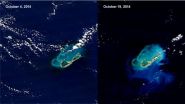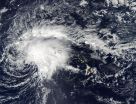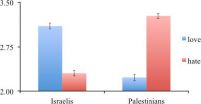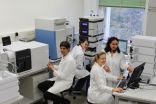(Press-News.org) A team of researchers led by NOAA's Office of National Marine Sanctuaries have discovered two significant vessels from World War II's Battle of the Atlantic. The German U-boat 576 and the freighter Bluefields were found approximately 30 miles off the coast of North Carolina. Lost for more than 70 years, the discovery of the two vessels, in an area known as the Graveyard of the Atlantic, is a rare window into a historic military battle and the underwater battlefield landscape of WWII.
"This is not just the discovery of a single shipwreck," said Joe Hoyt, a NOAA sanctuary scientist and chief scientist for the expedition. "We have discovered an important battle site that is part of the Battle of the Atlantic. These two ships rest only a few hundred yards apart and together help us interpret and share their forgotten stories."
On July 15, 1942, Convoy KS-520, a group of 19 merchant ships escorted by the U.S. Navy and Coast Guard, was en route to Key West, Florida, from Norfolk, Virginia, to deliver cargo to aid the war effort when it was attacked off Cape Hatteras. The U-576 sank the Nicaraguan flagged freighter Bluefields and severely damaged two other ships. In response, U.S. Navy Kingfisher aircraft, which provided the convoy's air cover, bombed U-576 while the merchant ship Unicoi attacked it with its deck gun. Bluefields and U-576 were lost within minutes and now rest on the seabed less than 240 yards apart.
"Most people associate the Battle of the Atlantic with the cold, icy waters of the North Atlantic," said David Alberg, superintendent of NOAA's Monitor National Marine Sanctuary. "But few people realize how close the war actually came to America's shores. As we learn more about the underwater battlefield, Bluefields and U-576 will provide additional insight into a relatively little-known chapter in American history."
The discovery of U-576 and Bluefields is a result of a 2008 partnership between NOAA and the Bureau of Ocean Energy Management to survey and document vessels lost during WWII off the North Carolina coast. Earlier this year, in coordination with Monitor National Marine Sanctuary, NOAA Ship Okeanos Explorer conducted an initial survey based on archival research. In August, archaeologists aboard NOAA research vessel SRVX Sand Tiger located and confirmed the ships' identities.
"This discovery highlights the importance of federal agencies working together to identify and protect these unique submerged archaeological resources that are of local and international importance," said William Hoffman, a BOEM archaeologist.
The newly identified wrecks are protected under international law. Although Bluefields did not suffer any casualties during the sinking, the wreck site is a war grave for the crew of U-576.
"In legal succession to the former German Reich, the Federal Republic of Germany, as a rule, sees itself as the owner of formally Reich-owned military assets, such as ship or aircraft wreckages," said the German Foreign Office in a statement. "The Federal Republic of Germany is not interested in a recovery of the remnants of the U-576 and will not participate in any such project. It is international custom to view the wreckage of land, sea, and air vehicles assumed or presumed to hold the remains of fallen soldiers as war graves. As such, they are under special protection and should, if possible, remain at their site and location to allow the dead to rest in peace."
United States policy on sunken state vessels, such as these, reaffirms sovereign government ownership of the wrecks, including German ownership of U-576. As stated in the 2001 Presidential Statement on United States Policy for the Protection of Sunken State Craft the wrecks are not considered abandoned nor does passage of time change their ownership.
Those who would engage in unauthorized activities directed at sunken State craft are advised that disturbance or recovery of such craft should not occur without the express permission of the sovereign government retaining ownership. The United States will use its authority to protect and preserve sunken State craft of the United States and other nations. For more information about the U.S. Policy on Sunken Warships see Federal Register Volume 69, Number 24 (Thursday, February 5, 2004)][Pages 5647-5648].
INFORMATION:
Other partners who participated in this effort include: NOAA's Office of Exploration and Research; the National Park Service American Battlefield Protection Program and Submerged Resource Center; East Carolina University, the University of North Carolina Coastal Studies Institute; and SRI International.
As part of the NOAA Battle of the Atlantic Research Project, extensive discussions took place with others including consultation with both Great Britain and Germany as well as the United States Navy and United States Coast Guard. State of the art marine technology provided high-resolution sonar imagery to corroborate historic and archival accounts of the final location and characteristics of each vessel.
Read more about and view high resolution images of the U-576 and Bluefields at http://monitor.noaa.gov/science/u-576.html.
NOAA's mission is to understand and predict changes in the Earth's environment, from the depths of the ocean to the surface of the sun, and to conserve and manage our coastal and marine resources. Join us on Twitter, Facebook, Instagram, and our other social media channels.
NASA's Aqua and Terra satellites captured before and after images of Bermuda and surrounding waters before and after Hurricane Gonzalo struck the island on Oct. 17. The images revealed how Gonzalo stirred up the sediment from the ocean bottom.
The MODIS instrument or Moderate Resolution Imaging Spectroradiometer that flies aboard NASA's Aqua and Terra satellites provided imagery of Bermuda and the stirred sediment. In a comparison of imagery before and after Hurricane Gonzalo passed, the after image showed sediment streaming east and south of Bermuda. The MODIS instrument ...
Slow-moving Tropical Storm Ana was still affecting parts of Hawaii on Oct. 20 when NASA's Aqua satellite passed overhead from its orbit in space. Imagery from Aqua showed that wind shear was affecting the storm.
The Moderate Resolution Imaging Spectroradiometer or MODIS instrument aboard NASA's Aqua satellite captured a visible picture of Tropical Storm Ana over Hawaii on Oct. 20 at 23:55 UTC (7:55 p.m. EDT). The image showed that most of the clouds and showers were north and east of the center of circulation, pushed away from the center by strong southwesterly wind ...
CHAMPAIGN, Ill. — Publicly traded corporations are increasingly publishing social responsibility reports for investors, who now consider such information alongside traditional financial data before investing in a company.
But according to new research from a University of Illinois expert in financial reporting and financial statement analysis, less-numerate investors are more susceptible to style and presentation effects of the reports, potentially leading them to make unintended judgments about the company.
W. Brooke Elliott, a professor of accountancy at Illinois, ...
CHICAGO –A new study in the Journal of Food Science, published by the Institute of Food Technologists (IFT), evaluated consumers' choice in fresh tomato selection and revealed which characteristics make the red fruit most appealing.
The researchers found that the most important fresh tomato attributes were color, amount of juice when sliced and size. Consumers were most drawn to fresh tomatoes shown to be red, firm, medium/small sized, crisp, meaty, and that contain few seeds.
The study also found that a lack of characteristic taste and flavor – including ...
What makes human conflict intractable – and how can psychological research resolve historic disagreements? A new study published in the Proceedings of the National Academy of Sciences by a team of researchers from The New School for Social Research, Northwestern University and Boston College demonstrates how seemingly unsolvable political and ethnic conflicts are fueled by asymmetrical perceptions of opponents' motivations – and that these tensions can be relieved by providing financial incentives to better understand what drives an adversary group.
"This ...
Boulder, CO, USA — Stegosaurs might be portrayed as lumbering plant eaters, but they were lethal fighters when necessary, according to paleontologists who have uncovered new evidence of a casualty of stegosaurian combat. The evidence is a fatal stab wound in the pubis bone of a predatory allosaur. The wound – in the conical shape of a stegosaur tail spike – would have required great dexterity to inflict and shows clear signs of having cut short the allosaur's life.
"A massive infection ate away a baseball-sized sector of the bone," reports Houston Museum ...
OAK RIDGE, Tenn., Oct. 21, 2014—Scientists at the Department of Energy's Oak Ridge National Laboratory have discovered exceptional properties in a garnet material that could enable development of higher-energy battery designs.
The ORNL-led team used scanning transmission electron microscopy to take an atomic-level look at a cubic garnet material called LLZO. The researchers found the material to be highly stable in a range of aqueous environments, making the compound a promising component in new battery configurations.
Researchers frequently seek to improve ...
Boulder, CO, USA — Washington's coast is so close to the seismically active Cascadia Subduction Zone that if a megathrust earthquake were to occur, a tsunami would hit the Washington shoreline in just 25 minutes.
One coastal community is preparing for such a disaster by starting construction on the nation's first tsunami evacuation refuge, large enough to shelter more than 1,000 people who are within 20-minute walking distance.
The vertical evacuation-refuge will be the roof of the gym of the new school in Grays Harbor County, Washington. The Ocosta Elementary ...
They may be tiny and stingless but there's nothing sweet and innocent about a species of native Sugarbag bee when it goes to war over a coveted honey-filled hive.
A study by behavioural ecologist Dr Paul Cunningham, from QUT, and molecular biologist Dr James Hereward, from the University of Queensland, published in American Naturalist, found the bees' used their jaws as lethal weapons when they zoomed in on a neighbouring Brisbane hive to boot out the inhabitants and install their own queen to rule.
Dr Cunningham said the attacking bees arrived in a swarm and clashed ...
This news release is available in German. Stroma cells are derived from connective tissue and may critically influence tumour growth. This knowledge is not new. However, bioanalyst Christopher Gerner and an interdisciplinary team from the University of Vienna and the Medical University of Vienna have developed a novel methodology for investigation. Using modern mass spectrometry, tumour-promoting activities from breast fibroblasts were directly determined from needle biopsy samples. Recently this experimental break-through is published in the renowned Journal of Proteome ...






